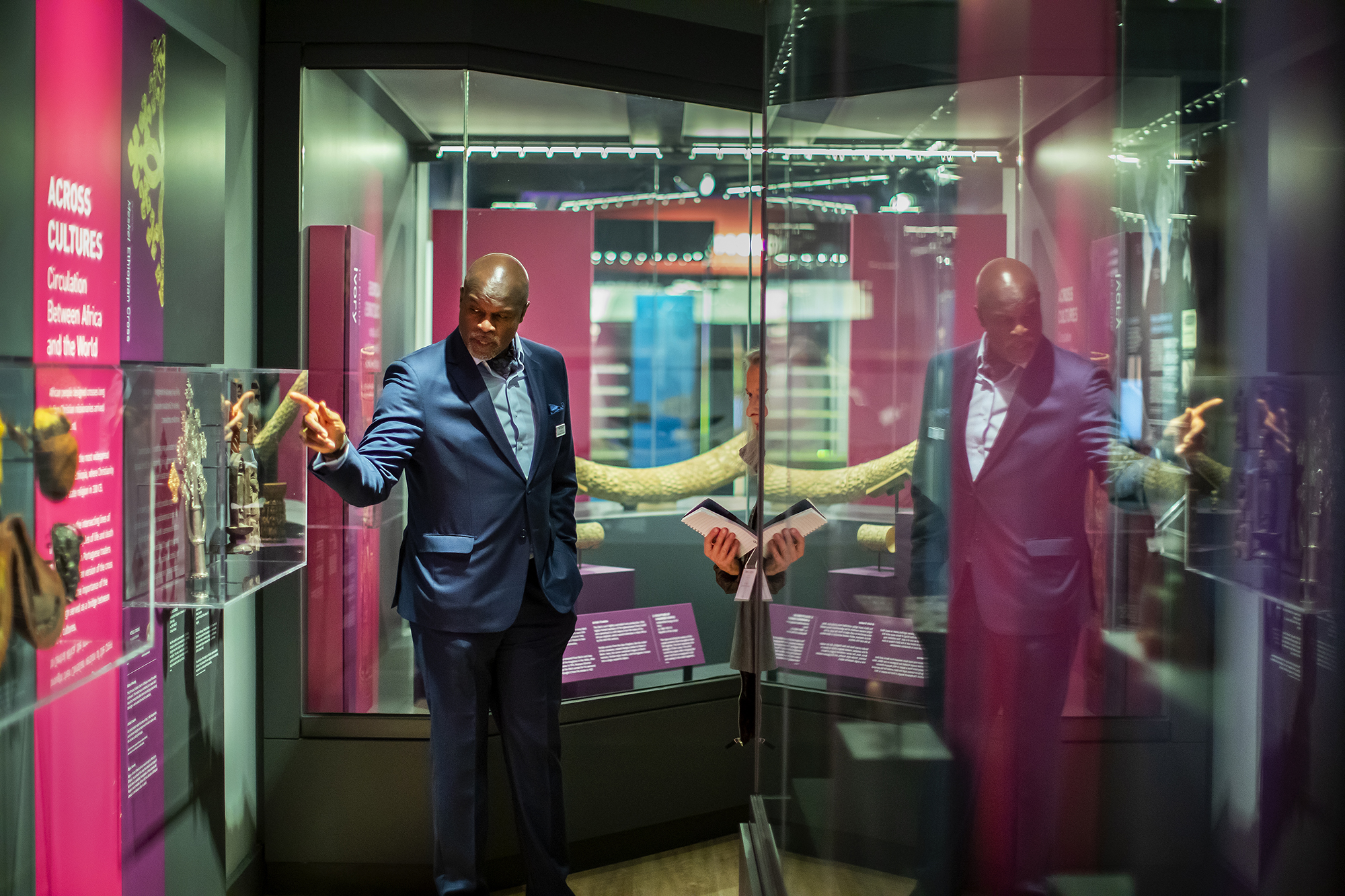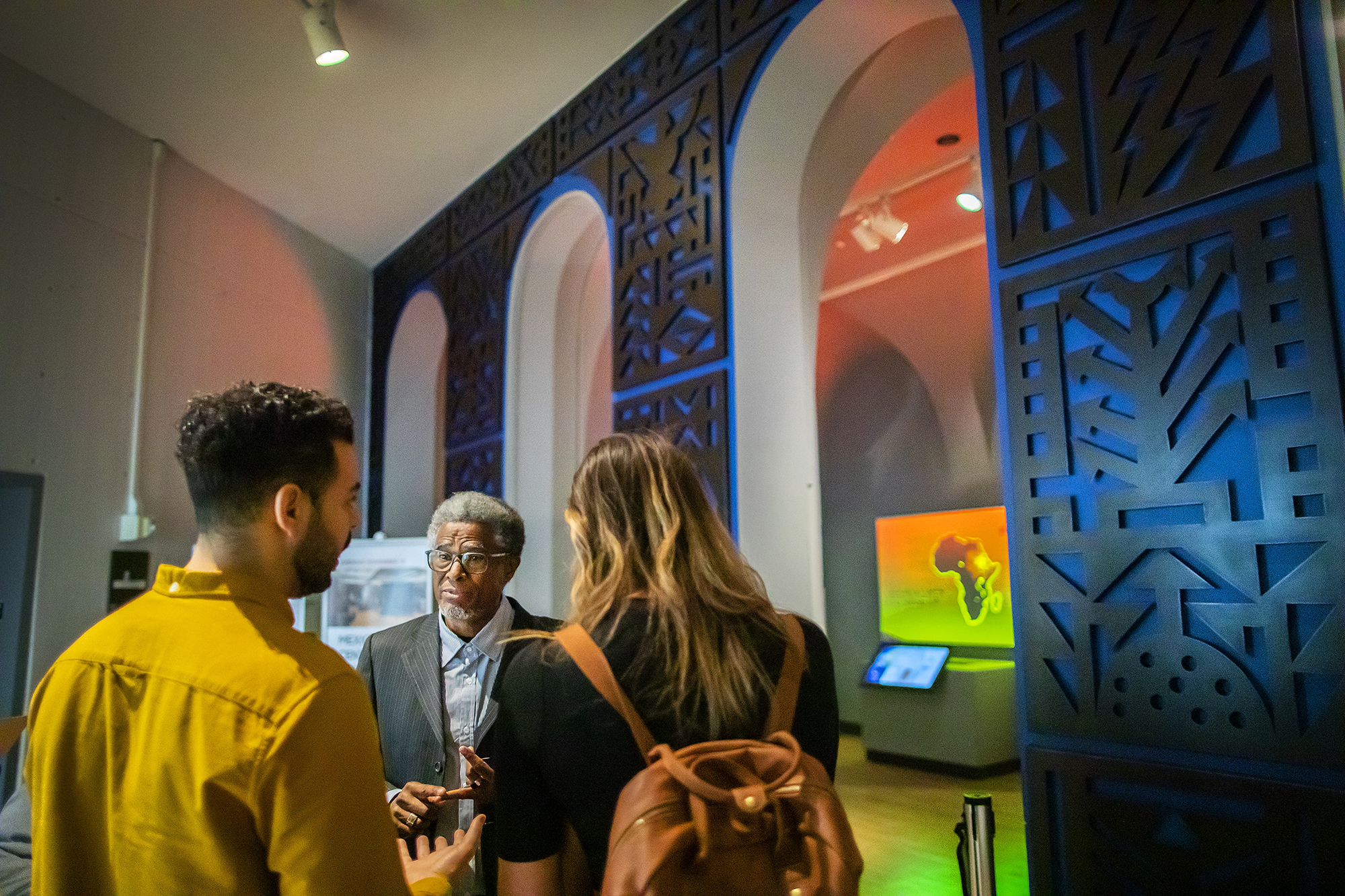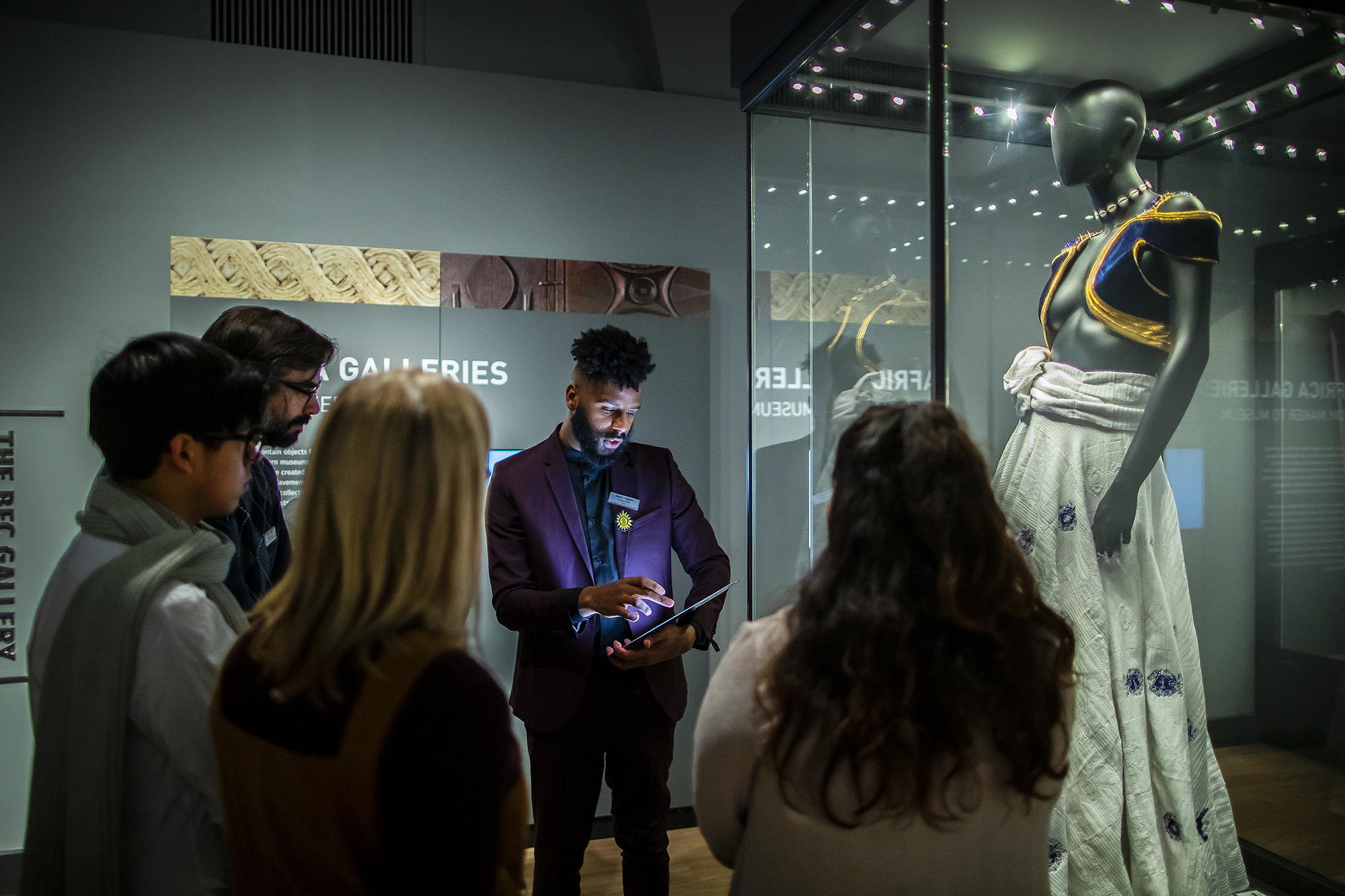
The recently reinstalled Africa Galleries at the Penn Museum encompass 4,000 square feet and nearly 300 artifacts from Africa and the African diaspora. In this reimagined space, the historical pieces—statues, gold coins, carved ivory, richly dyed textiles—are juxtaposed with three groupings of contemporary art commissioned by Professor Tukufu Zuberi, the Africa Galleries’ lead curator.
The installations, created by Breanna Moore and Emerson Ruffin (working in textiles), Jorge Dos Anjos (sculpture), and Muhsana Ali and Amadou Kane Sy (mixed media mosaic) enter into a dialogue with the historical pieces. Together, the works represent “Africa’s tremendous contribution to humanity,” Zuberi says.
The project took Zuberi an entire year just to conceptualize and four years to complete. “I needed to be open to doing something different,” he says. “I presented the idea that we have to connect the galleries to Africa and the African diaspora.” Zuberi wanted to place the legacy of slavery and colonialism in a broader setting that included both provenance and social context. “We have developed a communication around these objects of antiquity that says why this material is relevant today,” says Zuberi. “This gallery is about changing the narrative.”
A black steel façade with geometric motifs frames the café entrance of the Africa Galleries. Titled Wall of Memory for an Ancestral Palace, the work is set against a background of cobalt blue with an arched doorway and two niches with inset sculpture. The façade’s design utilizes symbols from the orishas, or deities, associated with Candomblé, a religion with Yoruba, Bantu, Fon, and Catholic origins that coalesced in South America. Candomblé means “dance in honor of the gods” and it is this spirit to which the artist, Jorge Dos Anjos of Ouro Preto, Brazil, pays homage.
“Candomblé is the gatekeeper of our memories,” Dos Anjos says. In Candomblé, traditions are passed from secretly from generation to generation to sustain the connection to Africa. Dos Anjos tells a story that when recently enslaved Africans were brought to Brazil, they were led around a tree blindfolded. “A metaphor for forgetting,” he says. “To forget everything about the past, including that they were people. The intention was to erase the memory.”
Dos Anjos cultivates and invokes this remembrance in his art. Born into a small-town Catholic family near an aluminum factory where his father worked, “I had no past,” Dos Anjos says. “Since, I’ve been seeking to find this lost memory.”
He’s found this through both religion and his work. On the right-hand side of the façade is a representation entitled Exú, also in black steel. Often reviled by Portuguese conquerors as a trickster, Exú is the intermediary between worlds, guarding both our entrance and exit.
Flanking Exú on the left is Nkisi N’Kondi, a protective figure from the 19th or early 20th century Congo. The Nkisi’s presence in a doorway welcomed visitors to a safe space within. Each piece of metal hammered into the wooden figure was an appeal to ancestral spirits, activating and invoking their protection. While the two works are more than a century apart, they are “seeking the same sense,” Dos Anjos says.
The ancestral connection was also sought by Breanna Moore and Emerson Ruffin, designers who worked in collaboration with Michael Stuart, Geri Gerard, and John Kwakye Wiredu as part of an artists’ collective in Ghana to create Wearable Literature. The work is a two-piece garment, the bottom a flowing white skirt done in kente cloth with embroidery overlay, and the top a cropped blue velvet bodice embellished with beads and gold trim inspired by the Solomonic dynasty of Ethiopia, Moore says.
Moore, who earned her bachelor’s degree at Penn, is now a first-year graduate student in the history department studying slavery and colonialism. “The main purpose of the dress was to highlight the importance of ancestor communication,” she says, “and for me it was important to do that through the drum.”
Kente cloth is the royal cloth of the Ashanti kingdom, Ruffin says. Instead of the traditional bright colors, he and Moore chose to make the fabric “white, like a book,” to reference the historical aspect. “Oftentimes where we learn about history, it’s in a book, but this is a history you can actually wear,” Ruffin says. The skirt’s fabric consists of four repeated patterns, three of which represent the elements of the drum: a tree used to make the body of the drum, a plant they use to extract the dye, and goat skin stretched across the surface. The fourth pattern is the Sankofa bird, associated with the Akan people in what is now Ghana. Roughly translated as “go back and get it,” the bird has become a diasporic symbol of historical awareness. Moore, who studied abroad in Ghana as an undergraduate, says the bird’s significance “is our need to return to the past, seek knowledge, and bring it back to the future. Being aware of who you are and where you came from.”
“We have a responsibility to our ancestors,” Moore says. “Our ancestors aren’t here to speak. This is what we say on their behalf.” One day, Moore and Ruffin will be the ancestors, and their work will continue to exist in the Penn Museum, in dialogue with future generations.
When Muhsana Ali and Amadou Kane Sy came to the Penn Museum in April, they took as their inspiration a peeling sticker that had been placed on an ivory tusk for object identification. The artists were struck by the fact that the objects in the African Galleries were never intended to end up there and wanted to reflect on that in their piece, bringing discarded objects from Senegal that were never meant to be in a museum, Ali says.
Presence of a Fundamental Absence is a mixed-media work. The artists collected discarded objects from Senegal—broken pottery, crushed cans, nails—and brought them to Philadelphia, where they embedded them in free form “continents” the color of red earth, some of which are in the shape of that sticker’s residue. Ali and Kane Sy worked out of Isaiah Zagar’s South Philadelphia studio using a process they call “poetic archaeology,” attaching the objects to sheetrock, securing them with grout, and then “unearthing” them.
Once part of the collection, each work is given an object number, which speaks to the object’s provenance and the date it was acquired or made. Labelling these objects gives them another meaning, Ali says. They incorporated these object labels in their work, using the same “AF” prefix that all the African objects bear with a random numerical suffix, sprinkled “like jazz” throughout the artwork, Kane Sy says. As part of the Penn Museum’s collection, Presence of a Fundamental Absence itself has an acquisition number. This number, EP.2013.74.6, has also been written on various objects throughout the piece.
In creating this work, the artists are seeking for “the birth of a new narrative around these objects,” says Kane Sy. They hope their work at Penn will foster a “a greater sensitivity towards Africa and the diaspora, suggesting a new perspective.”
Ali and Kane Sy are the Center of Africana Studies fall 2019 Artists-in-Residence. They offered master classes at the Center and the Penn Museum discussing their work and artistic process as part of their time here.
As museum culture evolves to resonate with contemporary generations, Zuberi looks to Africa, collaborating with African museums regarding the display of objects. “It’s about recognizing the colonial legacies of these museums as a project,” he says, which can be countered by engaging viewers in conversations that stimulate new memories and new meanings. “It’s a combination of humanity that’s the point,” Zuberi says, “a dynamic circulation of culture across space and across time.”
Tukufu Zuberi is professor of sociology and Africana studies and the Lasry Family Professor of Race Relations in the Department of Sociology in the School of Arts and Sciences.










